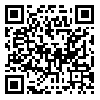Volume 22, Issue 3 (September 2024)
Iranian Rehabilitation Journal 2024, 22(3): 485-498 |
Back to browse issues page
Download citation:
BibTeX | RIS | EndNote | Medlars | ProCite | Reference Manager | RefWorks
Send citation to:



BibTeX | RIS | EndNote | Medlars | ProCite | Reference Manager | RefWorks
Send citation to:
Banari A, Aghaz A, Shahriyari A, Fakhimi F. Dysphagia and Dysphonia in COVID-19 Patients Hospitalized in the Ward Versus Intensive Care Unit. Iranian Rehabilitation Journal 2024; 22 (3) :485-498
URL: http://irj.uswr.ac.ir/article-1-1945-en.html
URL: http://irj.uswr.ac.ir/article-1-1945-en.html
1- Department of Speech Therapy, School of Rehabilitation Sciences, University of Social Welfare and Rehabilitation Sciences, Tehran, Iran.
2- Department of Speech Therapy, School of Rehabilitation Sciences, Isfahan University of Medical Sciences, Isfahan, Iran.
3- Department of Psychology, Faculty of Psychology and Educational Sciences, Central Tehran Branch, Islamic Azad University, Tehran, Iran.
2- Department of Speech Therapy, School of Rehabilitation Sciences, Isfahan University of Medical Sciences, Isfahan, Iran.
3- Department of Psychology, Faculty of Psychology and Educational Sciences, Central Tehran Branch, Islamic Azad University, Tehran, Iran.
Abstract: (2785 Views)
Objectives: COVID-19 was triggered by the severe acute respiratory syndrome coronavirus-2, leading to a pandemic. The risk of developing dysphonia and dysphagia amongst COVID-19 patients is considered to be high.
Methods: In this prospective study, 150 patients affected by COVID-19 admitted to the intensive care unit (ICU) and the ward of Firoozgar Hospital in Tehran, Iran, were analyzed. Dysphagia and dysphonia were evaluated according to the swallowing impairment score and the consensus auditory-perceptual evaluation of voice (CAPE-V). Also, the quality of life (QoL) was measured using the Persian version of the voice handicap index, the swallowing QoL and the Persian version of the dysphagia handicap index (DHI).
Results: A total of 150 COVID-19 patients (mean age: 59.64±17.87 years and 54.3% male; 75 admitted patients to the ICU and 75 patients admitted to the ward) were evaluated. A total of 115(77%) patients with COVID-19 were experiencing dysphagia, and the prevalence of dysphagia did not vary meaningfully between the two sets. According to the swallowing QoL, the QoL of the two groups was meaningly different (P<0.05). Also, the QoL of patients admitted to the ICU was lower than those admitted to the ward. A total of 91(61%) COVID-19 patients had dysphonia and dysphonia prevalence was significantly varied among the two groups (P<0.05). Investigating the relationship between dysphagia severity, dysphonia severity, and age showed a significantly positive correlation (P<0.01). However, the length of stay had a positive correlation only with the severity of dysphonia (P<0.05). Also, a negative correlation was found between swallowing QoL, dysphagia severity, and dysphonia severity (P<0.01).
Discussion: Dysphagia and dysphonia were prevalent among COVID-19 patients and more common in older patients. Early evaluation is required for timely and efficient intervention to avoid further complications and to progress their QoL.
Methods: In this prospective study, 150 patients affected by COVID-19 admitted to the intensive care unit (ICU) and the ward of Firoozgar Hospital in Tehran, Iran, were analyzed. Dysphagia and dysphonia were evaluated according to the swallowing impairment score and the consensus auditory-perceptual evaluation of voice (CAPE-V). Also, the quality of life (QoL) was measured using the Persian version of the voice handicap index, the swallowing QoL and the Persian version of the dysphagia handicap index (DHI).
Results: A total of 150 COVID-19 patients (mean age: 59.64±17.87 years and 54.3% male; 75 admitted patients to the ICU and 75 patients admitted to the ward) were evaluated. A total of 115(77%) patients with COVID-19 were experiencing dysphagia, and the prevalence of dysphagia did not vary meaningfully between the two sets. According to the swallowing QoL, the QoL of the two groups was meaningly different (P<0.05). Also, the QoL of patients admitted to the ICU was lower than those admitted to the ward. A total of 91(61%) COVID-19 patients had dysphonia and dysphonia prevalence was significantly varied among the two groups (P<0.05). Investigating the relationship between dysphagia severity, dysphonia severity, and age showed a significantly positive correlation (P<0.01). However, the length of stay had a positive correlation only with the severity of dysphonia (P<0.05). Also, a negative correlation was found between swallowing QoL, dysphagia severity, and dysphonia severity (P<0.01).
Discussion: Dysphagia and dysphonia were prevalent among COVID-19 patients and more common in older patients. Early evaluation is required for timely and efficient intervention to avoid further complications and to progress their QoL.
Article type: Original Research Articles |
Subject:
Speech therapy
Received: 2023/04/9 | Accepted: 2023/09/5 | Published: 2024/09/1
Received: 2023/04/9 | Accepted: 2023/09/5 | Published: 2024/09/1
Send email to the article author








